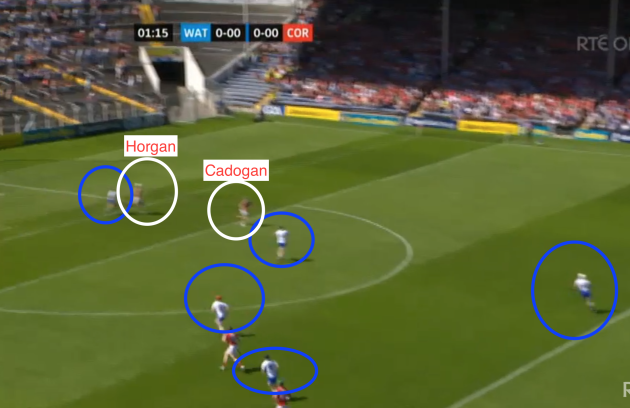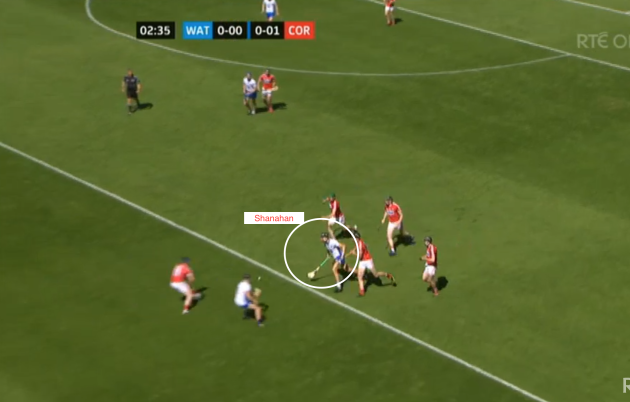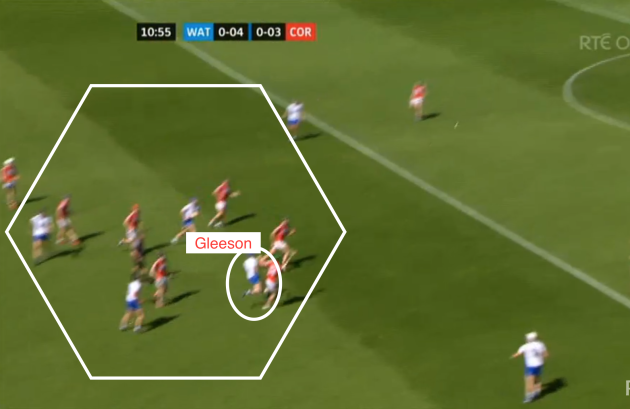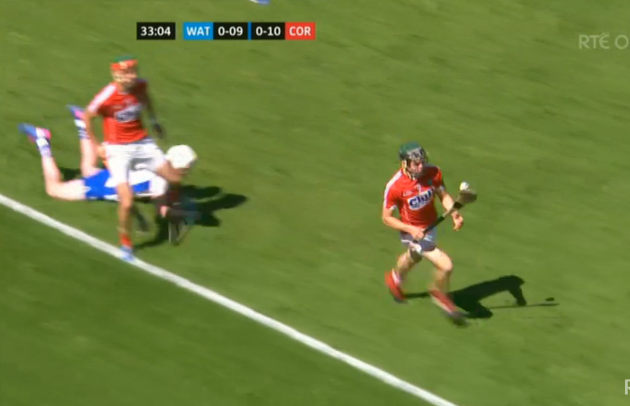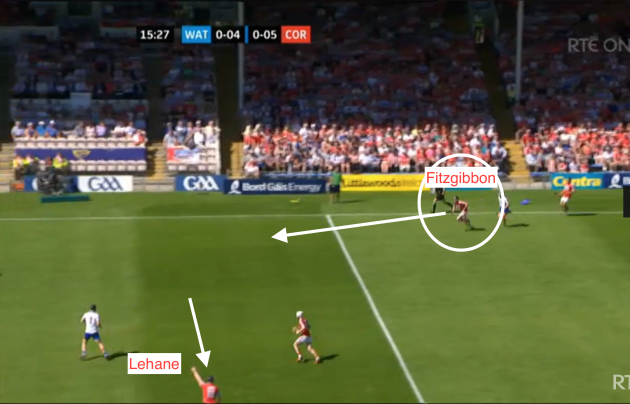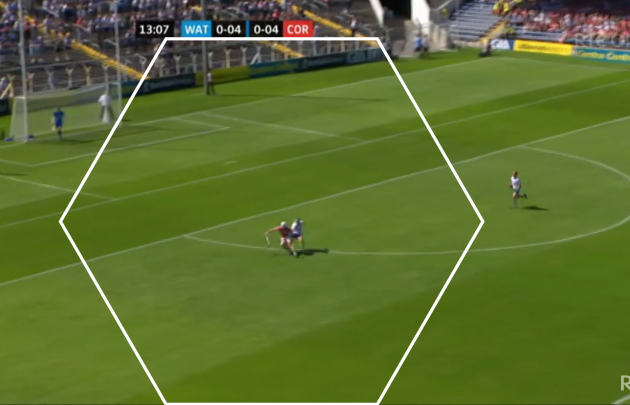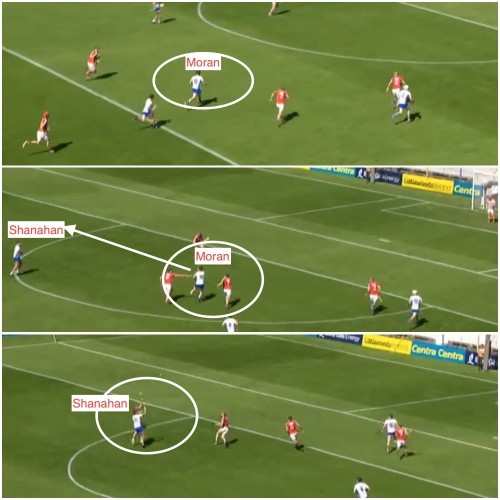CORK HIT THE ground running and Waterford looked off the pace right from the very start of yesterday’s Munster semi-final.
You’d have to suspect that the eleven-week break for Waterford was a factor in this.
Cork got into their rhythm quickly and didn’t really relent all the way through.
Waterford, in a sense, put all of their eggs into the championship basket from early in the year, because they didn’t really go after the League.
Unfortunately for them, that strategy didn’t really pay off and I felt they were in trouble from the off.
Early indicator
The second minute of the game provided a very clear and early indicator of Waterford’s issues, but also a real clue as to how Cork wanted to play the game.
Kevin Moran, from inside his own half, hits a very poor wide under no pressure at all and the resultant puck-out is taken quickly by Anthony Nash.
He picks out Luke Meade, uncontested, who finds himself in space:
The diagonal ball inside is aimed for Alan Cadogan but freezing the frame here, look at how badly Waterford (blue circles) are set up from a defensive viewpoint:
What puzzles me is that Waterford would have taken note of how Cork played against Tipperary, particularly the quality of Nash’s distribution and and how Cork made hay with diagonal balls of this nature.
Waterford aren’t engaged early enough – is the 11-week lay-off a factor here?
From what I saw, and this is a very clear example, they didn’t have the answers to Cork and that’s a tough pill to swallow, when they would have known how the Rebels wanted to play.
Cadogan initially spills the delivery from Meade but Horgan has also drifted out to the side to mop up the second ball, and he scores Cork’s opening point.
Good Cork defence
I referenced this after the Tipperary game and it’s worth pointing out again.
The way Cork had been playing until this year, defensively, had been all over the place, quite frankly.
It was a huge Achilles heel for them but they were excellent against Tipp and upped the ante again yesterday.
Here are a few examples to back that up.
First of all, we have a puck-out from Stephen O’Keeffe, a long one down into the heart of the Cork defence.
As the ball breaks, look at the amount of bodies around Shane Bennett, the Waterford player in possession:
As play develops, Bennett is turned over but re-gathers possession.
He’s forced outside to Maurice Shanahan but again, the Cork cavalry arrive to close down the Waterford man:
Shanahan’s turned over and the ball is eventually cleared by Conor Lehane, who’s back working deep inside his own half.
In that picture above, you have five Cork players in and around Shanahan.
This was a feature of Cork’s defence, hunting down Waterford opponents in strong numbers.
Of course, they weren’t always able to get as many as five players in the contact zone and this was early in the game but this further illustrates my point that Cork hit the ground running.
That’s the beauty of having a championship match under their belts, they were into the flow of the game almost immediately.
You can’t underestimate the value of a previous game, particularly in the context of Cork, a fresh team with a number of new players. They’re hungry, young, bursting for road. This is manna from Heaven for them.
They had that match against Tipperary four weeks ago and answered loads of questions.
They developed a huge amount of confidence from that and carried it into the Waterford match.
Having beaten the All-Ireland champions, you can be sure that Waterford held no fear for them, and that was very evident in their play early on.
Even in a one-on-one situation, Cork did very well in the next example.
Maurice Shanahan does brilliantly to catch a high ball under pressure from Damien Cahalane but the Cork player’s defending is excellent.
He forces Shanahan to check back inside, before executing a superb block:
The ball spins into the air and Shanahan wins it again but Cahalane’s defending is textbook, sending the forward wide and into a tricky shooting position, from where he sends the ball wide:
Here’s an Austin Gleeson wide in the 11th minute. Before this, Kevin Moran had been harried by a posse of Cork defenders but look at the amount of Cork bodies around the ball as Gleeson is hurried into his shot, and it goes wide.
In the freeze frame, look at the zone highlighted, with six Cork bodies outnumbering four Waterford, and Gleeson sends his effort wide:
There are a couple of things I would say on Gleeson. The first thing is that they used him very sparingly during the League, which I thought was noteworthy at the time.
The objective there was to keep him fresh and hungry, but that back-fired because he didn’t look sharp at all.
That was a general trend, however, because most of the Waterford players, bar Stephen O’Keeffe and Jamie Barron, wouldn’t have been happy with their overall displays.
Austin’s only 21 years of age, we shouldn’t forget that, and in terms of inter-county experience, he’s still coming to terms with that.
That’s a huge factor because there have been very few players of the year at that tender age, and so much expectation comes with that tag, and perhaps it’s a heavier burden than it would be for an older player.
His role looked to be a very loose role yesterday, very much dictated by himself to a large extent. That can be a good thing sometimes, but if you don’t have a fixed position or defined role in attack, defence or midfield, unless you’re in the game very early, it can be difficult to feature.
If he was played at centre forward, similar to Joe Canning in Galway, and left there, he might have profited.
But he looked all over the place, even though he scored two superb points from play.
The man remains an outstanding player, that’s not going to change. This often happens when you’re coming in on the back of a huge season, people think you can automatically pick up where you left off but sport doesn’t always work like that.
But it was good to read Derek McGrath’s comments this morning, when he spoke about how Austin reacted positively to being taken off.
Going back to Cork’s defending, this next example shows a grounded Pauric Mahony, having contested a Stephen O’Keeffe puck-out close to the touchline.
Christopher Joyce (5) has applied the initial pressure but Luke Meade (10) is arriving to offer support. The ball eventually trickles out over the line and Cork win the line-ball:
Another great example of Cork backing each other up occurred in the 34th minute.
As the ball is arrowed in by Waterford, I’ve highlighted the covering player, Mark Coleman:
In the next shot, Coleman’s on the ball having mopped up the pieces and is preparing to deliver down the left touchline to Patrick Horgan:
As play develops, Horgan plays a lovely ball inside to Seamus Harnedy, who forces a brilliant save from O’Keeffe.
As well as out-and-out defensive quality from Coleman in this instance, what was really admirable was his use of ball coming out of defence. It was very rare that Cork hit a long, hopeful ball into their forwards.
Now and again it happened but it was seldom. They were consistently picking out players.
This next example perfectly highlights Cork’s good use of the ball.
Initially, it’s Mark Ellis mopping up before playing a ball to Christopher Joyce.
Joyce moves out of defence and plays a simple handpass to Darragh Fitzgibbon, in space:
Conor Lehane, the eventual point-scorer, is already alive to the possibility and you can see him in the bottom of the next shot, with his hand in the air:
Fitzgibbon obliges with a simple pass and Lehane sends the ball over from distance.
It’s just really good play from Cork, and pretty uncomplicated with support players offering good options.
There was another excellent second half example of Cork inter-play, and working the ball well out of defence.
After lost possession late in the 52nd minute, Damien Cahalane was on hand to offer support. Again, simple ball to Fitzgibbon, to Colm Spillane, and down the line to Alan Cadogan.
The Cork forward turned his man and sent over a cracking score. Again, Cork defending superbly but also, and critically, using the ball well having worked so hard to win possession in the first place.
Cork’s use of diagonal ball
I just have to come back to this, because it was such a key trend in the game.
Cork do so much damage with these deliveries and what you see is their inside forwards starting from fairly central positions, making those runs towards the sidelines.
It’s a tactic that’s very difficult to defend against, it allows Cork to play to their strengths and it gives them a great chance of winning possession.
4th minute – A delivery from Ellis is aimed for Patrick Horgan and while Noel Connors gets a good tackle in, the ball breaks to Darragh Fitzgibbon and he scores a point.
14th minute – the Cork diagonal ball works again (Seamus Harnedy this time), and leads to a goal chance for Patrick Horgan. Freezing the play in the next shot, you can see the amount of space in front of the Cork forward:
If you replay that passage of play, before Horgan shoots wide, there’s a brilliant little flick from the Cork player as he allows the ball to run through him, before turning to advance on goal.
Horgan knows that he can beat Connors on the turn so he’s not going to take possession first time and round his man.
It’s just another illustration of Cork in full flow, dictating the game and playing it on their terms. Waterford are treading water.
42nd minute – another diagonal ball leads to a Patrick Horgan point, after Cork win dirty ball inside their own half.
64th minute – A Seamus Harnedy point from play originates from another diagonal ball, this time from a sideline cut.
Waterford off-colour
Waterford weren’t sharp. There was that early miss from Kevin Moran that I referenced at the start but there were other examples of this.
9th minute – Maurice Shanahan shoots a poor wide from play under no real pressure.
14th minute – This was a poor one for Waterford.
In the three shots collated below, we first of all see Kevin Moran bursting through into plenty of space. He elects to play a handpass aimed at Maurice Shanahan to his left, but it’s overcooked, spooned into the air and Cork mop it up comfortably:
On a wider issue, nobody would have been surprised if Waterford used the sweeper system but you can’t get inside the minds of their players.
Who’s to say that actually wanted to use it? Maybe they’re trying to get away from that stereotype?
You have to remember that Waterford’s last championship game was against Kilkenny in last year’s All-Ireland semi-final replay, when they didn’t play a sweeper and produced some outstanding stuff.
They obviously had their preparation done for this game, and felt that if they executed their gameplan as they wanted to, that it it would have been good enough.
Bear in mind that Waterford had 16 wides so it wasn’t as if they weren’t creating chances.
It’s not necessarily the case that they were overly-exposed defensively but they did have those wides and the Cork defence ran the show.
My argument would be that that’s not as a result of Waterford not playing a sweeper, but that they weren’t clinical enough with the chances that came their way.
Playing with or without a sweeper is not the winning and losing of matches primarily, the real key is being able to execute the chances they create, and the couple of examples above clearly indicate how they butchered some good opportunities.
If Waterford had to play the game on their terms, that meant closing down Anthony Nash’s puck-outs, and putting huge pressure on Cork’s distribution from deep areas.
That would have effectively reduced the need to play a covering defender in the first place.
Basically, Cork shouldn’t have been allowed to put the ball into the pockets of space they targeted, while there were also a number of examples of Cork hitting long puck-outs and not winning them.
What Waterford wanted to do was force Cork to go long on the puck-outs and when they did, the Déise were able to win them.
8th minute – Cork puck-out goes long, there’s a tussle for possession but Waterford win the ruck.
12th minute – No short option for Anthony Nash and he goes long. The ball is touched out over the line by Shane Fives, and Cork win the sideline ball.
20th minute – Lengthy Nash free cleared by Waterford.
From a Waterford perspective, however, forcing Cork to go long didn’t happen often enough.
That changes the whole dynamic of a game, not just on puck-outs and generally long deliveries, but in general play.
You only have to look at the examples above of Cork being able to pick out their men and create space pretty much as they pleased.
Conclusion
I wasn’t really sure whether Cork’s performance against Tipp was hugely impressive and facilitated by Tipp’s lethargy but this latest display blew that theory out of the water.
Cork completely outplayed Waterford, with almost a carbon copy of the style with which they dismissed Tipp.
Waterford don’t have the same calibre of forward that Tipp possess, arguably, but even so, Cork looked even more impressive yesterday.
They had a maturity and composure about them, played with a lot of intelligence and knew exactly what they were doing.
They were extremely disciplined and overall, they’re in a great place with serious momentum built up.
They have quality, they have pace and they’re playing with a style that suits them.
The big question for Waterford is why they allowed Cork to dictate the terms of engagement in that manner? I can only conclude that Waterford simply weren’t capable of closing Cork down.
The42 is on Instagram! Tap the button below on your phone to follow us!

